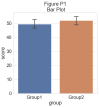Raincloud plots: a multi-platform tool for robust data visualization
- PMID: 31069261
- PMCID: PMC6480976
- DOI: 10.12688/wellcomeopenres.15191.2
Raincloud plots: a multi-platform tool for robust data visualization
Abstract
Across scientific disciplines, there is a rapidly growing recognition of the need for more statistically robust, transparent approaches to data visualization. Complementary to this, many scientists have called for plotting tools that accurately and transparently convey key aspects of statistical effects and raw data with minimal distortion. Previously common approaches, such as plotting conditional mean or median barplots together with error-bars have been criticized for distorting effect size, hiding underlying patterns in the raw data, and obscuring the assumptions upon which the most commonly used statistical tests are based. Here we describe a data visualization approach which overcomes these issues, providing maximal statistical information while preserving the desired 'inference at a glance' nature of barplots and other similar visualization devices. These "raincloud plots" can visualize raw data, probability density, and key summary statistics such as median, mean, and relevant confidence intervals in an appealing and flexible format with minimal redundancy. In this tutorial paper, we provide basic demonstrations of the strength of raincloud plots and similar approaches, outline potential modifications for their optimal use, and provide open-source code for their streamlined implementation in R, Python and Matlab ( https://github.com/RainCloudPlots/RainCloudPlots). Readers can investigate the R and Python tutorials interactively in the browser using Binder by Project Jupyter.
Keywords: Matlab; Python; R; barplots; data visualization; raincloud plots.
Copyright: © 2021 Allen M et al.
Conflict of interest statement
No competing interests were disclosed.
Figures
















































References
-
- Allen M, Poggiali D, Whitaker K, et al. : RainCloudPlots tutorials and codebase (Version v1.0). Zenodo. 2018. 10.5281/zenodo.1402959 - DOI
-
- #barbarplots.2016. Reference Source
-
- Bobko P, Karren R: The Perception of Pearson Product Moment Correlations from Bivariate Scatterplots. Pers Psychol. 1979;32(2):313–325. 10.1111/j.1744-6570.1979.tb02137.x - DOI
-
- Chambers JM: Graphical Methods for Data Analysis.Chapman and Hall/CRC.2017. 10.1201/9781351072304 - DOI
-
- Eklund A: beeswarm: the bee swarm plot, an alternative to stripchart. R package version 0.2.3.2016. Reference Source
Grants and funding
LinkOut - more resources
Full Text Sources
Other Literature Sources
Molecular Biology Databases

